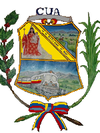Cúa
|
Cúa Nuestra Señora del Rosario de Cúa |
|||
|---|---|---|---|

Our Lady of the Rosary of Cúa Church
|
|||
|
|||
| Nickname(s): The Tuy Pearl | |||
| Coordinates: 10°10′N 66°53′W / 10.167°N 66.883°WCoordinates: 10°10′N 66°53′W / 10.167°N 66.883°W | |||
| Country |
|
||
| State | Miranda | ||
| Municipality | Urdaneta | ||
| Government | |||
| • Mayor | Edicson Sarmientos (2008–2012) | ||
| Area | |||
| • Total | 273 km2 (105 sq mi) | ||
| Elevation | 490 m (1,610 ft) | ||
| Population (July 1, 2009) | |||
| • Total | 127,900 | ||
| • Density | 468.50/km2 (1,213.4/sq mi) | ||
| Climate | Aw | ||
| Website | Urdaneta Municipality website | ||
Cúa (founded in 1690) is a small city capital of the Urdaneta Municipality, located in the Miranda State (Estado Miranda) in the north of Venezuela with an altitude of 490 m. Cúa is noted for warm and clear weather, with year-round sunshine and 60 days of rainfall annually, and an average temperature that range from 18 °C to 28 °C, but with relative low humidity.
With leafy forest and meadows, Cúa has a population of 123,000 (2004), mainly dedicated to services and industry (plastic pipes, paper rolls) it's a dormitory town. The most important districts of Cúa are: Nueva Cúa, Lecumberry, La Fila, Mume, Santa rosa and Aparay.
The local Sanctuary of the Virgin of Betania has become famous for its attributed Marian apparitions.
Cúa is one of the locations served by the IFE Ezequiel Zamora Mass Transportation System.
The first establishments of Cúa dates from the pre-Columbian period, being the first founders the Quiriquires natives, has like nickname The Tuy Pearl, because its location at the borders of the Tuy River. After the officially foundation on October 6, 1690 by Fray Manuel de Alesson, under the invocation of Our Lady of the Rosary of Cúa, the first inhabitants came from different regions motivated by the agriculture, due to the fertility and strategic location of the valley. However, this town was founded initially at the site known as Marín in 1633, this first village was destroyed in its totality by a violent earthquake that affected a great part of the Tuy Valleys.
The name of Cúa, according to some historians, has it origin from the Cumanagotos natives, from the Carib language that means Crab, meaning that Cúa is the place where the crab abounds. Others affirm that its name is associate with Apacuana, a brave native woman from the region, that fought against the Spaniards. Others think that that name was giving in honor to the native Cue, ally of the Spaniards, that helped in the foundation and consolidation of the town.
...
Wikipedia



